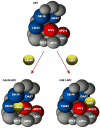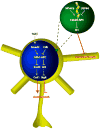The dynamic ubiquitin ligase duo: Cdh1-APC and Cdc20-APC regulate neuronal morphogenesis and connectivity
- PMID: 20060286
- PMCID: PMC3118470
- DOI: 10.1016/j.conb.2009.12.004
The dynamic ubiquitin ligase duo: Cdh1-APC and Cdc20-APC regulate neuronal morphogenesis and connectivity
Abstract
The proper development and patterning of axons, dendrites, and synapses is essential for the establishment of accurate neuronal circuits in the brain. A major goal in neurobiology is to identify the mechanisms and principles that govern these fundamental developmental events of neuronal circuit formation. In recent years, exciting new studies have suggested that ubiquitin signaling pathways may play crucial roles in the control of neuronal connectivity. Among E3 ubiquitin ligases, Cdh1-anaphase promoting complex (Cdh1-APC) and Cdc20-APC have emerged as key regulators of diverse aspects of neuronal connectivity, from axon and dendrite morphogenesis to synapse differentiation and remodeling.
2009 Elsevier Ltd. All rights reserved.
Figures




Similar articles
-
An old dog learns new tricks: a novel function for Cdc20-APC in dendrite morphogenesis in neurons.Cell Cycle. 2010 Feb 1;9(3):482-5. doi: 10.4161/cc.9.3.10558. Cell Cycle. 2010. PMID: 20195072 Free PMC article.
-
Novel functions for the anaphase-promoting complex in neurobiology.Semin Cell Dev Biol. 2011 Aug;22(6):586-94. doi: 10.1016/j.semcdb.2011.03.006. Epub 2011 Mar 23. Semin Cell Dev Biol. 2011. PMID: 21439392 Free PMC article. Review.
-
Expression of the CDH1-associated form of the anaphase-promoting complex in postmitotic neurons.Proc Natl Acad Sci U S A. 1999 Sep 28;96(20):11317-22. doi: 10.1073/pnas.96.20.11317. Proc Natl Acad Sci U S A. 1999. PMID: 10500174 Free PMC article.
-
A Cdc20-APC ubiquitin signaling pathway regulates presynaptic differentiation.Science. 2009 Oct 23;326(5952):575-8. doi: 10.1126/science.1177087. Science. 2009. PMID: 19900895 Free PMC article.
-
The anaphase-promoting complex/cyclosome (APC/C): cell-cycle-dependent and -independent functions.Biochem Soc Trans. 2010 Feb;38(Pt 1):65-71. doi: 10.1042/BST0380065. Biochem Soc Trans. 2010. PMID: 20074037 Review.
Cited by
-
SnoN: bridging neurobiology and cancer biology.Curr Mol Med. 2010 Oct;10(7):667-73. doi: 10.2174/156652410792630616. Curr Mol Med. 2010. PMID: 20712586 Free PMC article.
-
A Cdh1-APC/FMRP Ubiquitin Signaling Link Drives mGluR-Dependent Synaptic Plasticity in the Mammalian Brain.Neuron. 2015 May 6;86(3):726-39. doi: 10.1016/j.neuron.2015.03.049. Epub 2015 Apr 23. Neuron. 2015. PMID: 25913861 Free PMC article.
-
SAMBA, a plant-specific anaphase-promoting complex/cyclosome regulator is involved in early development and A-type cyclin stabilization.Proc Natl Acad Sci U S A. 2012 Aug 21;109(34):13853-8. doi: 10.1073/pnas.1211418109. Epub 2012 Aug 6. Proc Natl Acad Sci U S A. 2012. PMID: 22869741 Free PMC article.
-
Protein degradation and memory formation.Brain Res Bull. 2011 Apr 25;85(1-2):14-20. doi: 10.1016/j.brainresbull.2010.11.002. Epub 2010 Nov 13. Brain Res Bull. 2011. PMID: 21078374 Free PMC article. Review.
-
Altered social behavior and neuronal development in mice lacking the Uba6-Use1 ubiquitin transfer system.Mol Cell. 2013 Apr 25;50(2):172-84. doi: 10.1016/j.molcel.2013.02.014. Epub 2013 Mar 14. Mol Cell. 2013. PMID: 23499007 Free PMC article.
References
-
- Peters JM. The anaphase promoting complex/cyclosome: a machine designed to destroy. Nat Rev Mol Cell Biol. 2006;7:644–656. - PubMed
-
- Harper JW, Burton JL, Solomon MJ. The anaphase-promoting complex: it’s not just for mitosis any more. Genes Dev. 2002;16:2179–2206. - PubMed
-
- Glotzer M, Murray AW, Kirschner MW. Cyclin is degraded by the ubiquitin pathway. Nature. 1991;349:132–138. - PubMed
Publication types
MeSH terms
Substances
Grants and funding
LinkOut - more resources
Full Text Sources
Other Literature Sources
Miscellaneous

